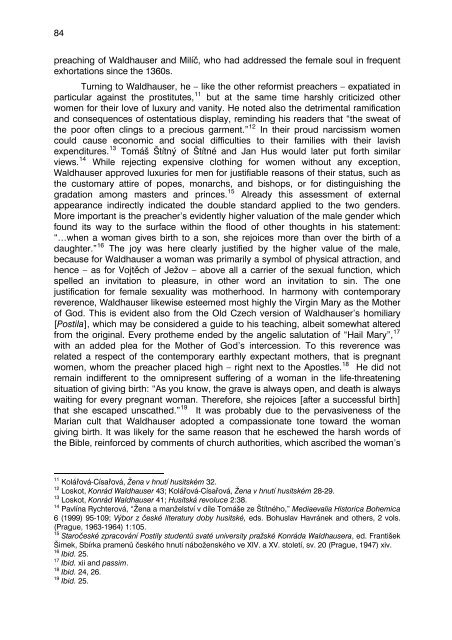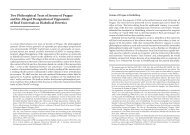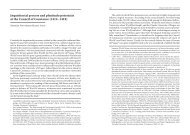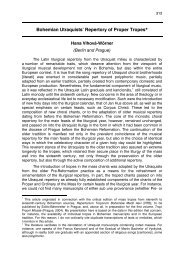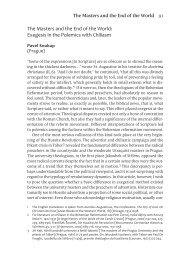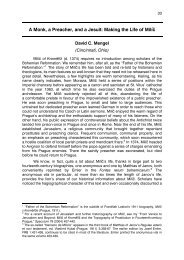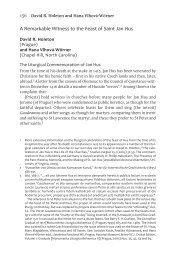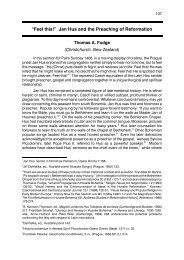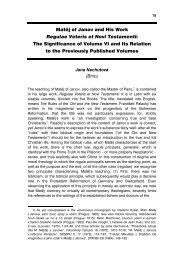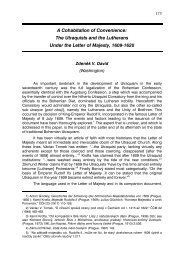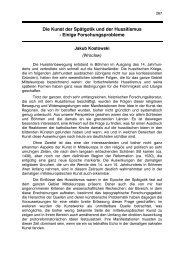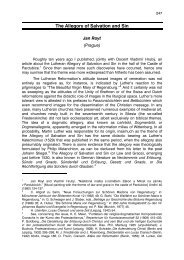quod mulieres, que sunt in Christo, in hoc - Bohemian Reformation ...
quod mulieres, que sunt in Christo, in hoc - Bohemian Reformation ...
quod mulieres, que sunt in Christo, in hoc - Bohemian Reformation ...
You also want an ePaper? Increase the reach of your titles
YUMPU automatically turns print PDFs into web optimized ePapers that Google loves.
84<br />
preach<strong>in</strong>g of Waldhauser and Milíč, who had addressed the female soul <strong>in</strong> fre<strong>que</strong>nt<br />
exhortations s<strong>in</strong>ce the 1360s.<br />
Turn<strong>in</strong>g to Waldhauser, he – like the other reformist preachers – expatiated <strong>in</strong><br />
particular aga<strong>in</strong>st the prostitutes, 11 but at the same time harshly criticized other<br />
women for their love of luxury and vanity. He noted also the detrimental ramification<br />
and conse<strong>que</strong>nces of ostentatious display, rem<strong>in</strong>d<strong>in</strong>g his readers that “the sweat of<br />
the poor often cl<strong>in</strong>gs to a precious garment.” 12 In their proud narcissism women<br />
could cause economic and social difficulties to their families with their lavish<br />
expenditures. 13 Tomáš Štítný of Štítné and Jan Hus would later put forth similar<br />
views. 14 While reject<strong>in</strong>g expensive cloth<strong>in</strong>g for women without any exception,<br />
Waldhauser approved luxuries for men for justifiable reasons of their status, such as<br />
the customary attire of popes, monarchs, and bishops, or for dist<strong>in</strong>guish<strong>in</strong>g the<br />
gradation among masters and pr<strong>in</strong>ces. 15 Already this assessment of external<br />
appearance <strong>in</strong>directly <strong>in</strong>dicated the double standard applied to the two genders.<br />
More important is the preacher’s evidently higher valuation of the male gender which<br />
found its way to the surface with<strong>in</strong> the flood of other thoughts <strong>in</strong> his statement:<br />
“…when a woman gives birth to a son, she rejoices more than over the birth of a<br />
daughter.” 16 The joy was here clearly justified by the higher value of the male,<br />
because for Waldhauser a woman was primarily a symbol of physical attraction, and<br />
hence – as for Vojtěch of Ježov – above all a carrier of the sexual function, which<br />
spelled an <strong>in</strong>vitation to pleasure, <strong>in</strong> other word an <strong>in</strong>vitation to s<strong>in</strong>. The one<br />
justification for female sexuality was motherhood. In harmony with contemporary<br />
reverence, Waldhauser likewise esteemed most highly the Virg<strong>in</strong> Mary as the Mother<br />
of God. This is evident also from the Old Czech version of Waldhauser’s homiliary<br />
[Postila], which may be considered a guide to his teach<strong>in</strong>g, albeit somewhat altered<br />
from the orig<strong>in</strong>al. Every protheme ended by the angelic salutation of “Hail Mary”, 17<br />
with an added plea for the Mother of God’s <strong>in</strong>tercession. To this reverence was<br />
related a respect of the contemporary earthly expectant mothers, that is pregnant<br />
women, whom the preacher placed high – right next to the Apostles. 18 He did not<br />
rema<strong>in</strong> <strong>in</strong>different to the omnipresent suffer<strong>in</strong>g of a woman <strong>in</strong> the life-threaten<strong>in</strong>g<br />
situation of giv<strong>in</strong>g birth: “As you know, the grave is always open, and death is always<br />
wait<strong>in</strong>g for every pregnant woman. Therefore, she rejoices [after a successful birth]<br />
that she escaped unscathed.” 19 It was probably due to the pervasiveness of the<br />
Marian cult that Waldhauser adopted a compassionate tone toward the woman<br />
giv<strong>in</strong>g birth. It was likely for the same reason that he eschewed the harsh words of<br />
the Bible, re<strong>in</strong>forced by comments of church authorities, which ascribed the woman’s<br />
11<br />
Kolářová-Císařová, Žena v hnutí husitském 32.<br />
12<br />
Loskot, Konrád Waldhauser 43; Kolářová-Císařová, Žena v hnutí husitském 28-29.<br />
13<br />
Loskot, Konrád Waldhauser 41; Husitská revoluce 2:38.<br />
14<br />
Pavlína Rychterová, “Žena a manželství v díle Tomáše ze Štítného,” Mediaevalia Historica Bohemica<br />
6 (1999) 95-109; Výbor z české literatury doby husitské, eds. Bohuslav Havránek and others, 2 vols.<br />
(Prague, 1963-1964) 1:105.<br />
15<br />
Staročeské zpracování Postily studentů svaté university pražské Konráda Waldhausera, ed. František<br />
Šimek, Sbírka pramenů českého hnutí náboženského ve XIV. a XV. století, sv. 20 (Prague, 1947) xiv.<br />
16<br />
Ibid. 25.<br />
17<br />
Ibid. xii and passim.<br />
18<br />
Ibid. 24, 26.<br />
19<br />
Ibid. 25.


